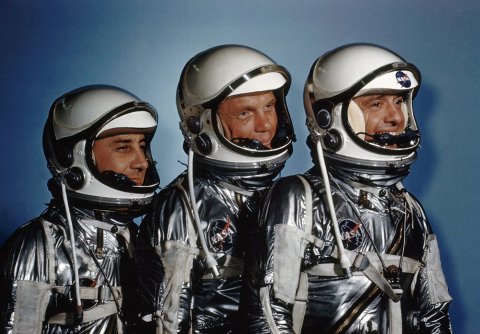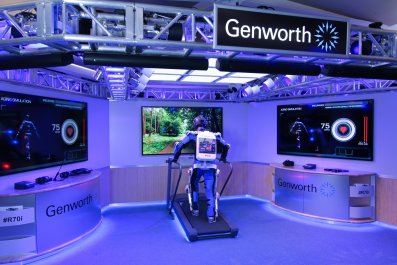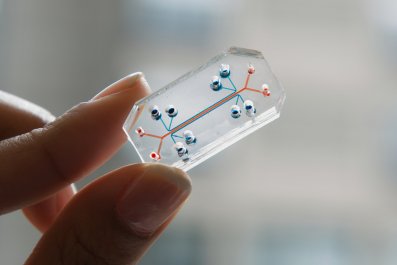A crew member aboard the International Space Station (ISS) is performing routine maintenance. Needing her hands free to complete the job, she verbally commands her procedures device, which looks a bit like a backward headlamp and acts a bit like Siri, to read the instructions aloud. Per its directives, she removes a wall panel to examine a valve for bacterial growth.
Midway through the inspection, a sensor embedded in her warning device, a harness worn beneath the uniform, detects a dangerous buildup of CO2 caused by the crew member exhaling in the closed, unventilated space behind the panel. The warning device sends that information to the procedures device, which cautions her about the danger. She speeds up and completes the job in time to avoid any harm. Then she moves on to manage one of the ISS mission's current experiments, checking the most recent data readings on her monitoring device, a kind of iPad Mini mounted to an upper thigh. Throughout all of this, sensors embedded in her uniform have also been collecting biomedical information, which will automatically be transmitted to researchers at Mission Control.
Those last paragraphs were a complete fabrication. In reality, many of the tools astronauts are using in 2015 haven't changed since the 1960s. "It's amazing how hard it is to beat a notebook taped to the wrist, which they've used since Apollo," says Cory Simon, manager of the NASA Wearable Electronics Application and Research (WEAR) Lab.
"We actually have a laminated plastic checklist that's mounted on the wrist," explains Robert Trevino, a crew systems project leader with NASA's Engineering Design and Analysis Branch/Crew and Thermal Systems Division. "Many years ago, we did look at an electronic checklist. We used LCD, liquid crystal screens. We did some testing, but it got much colder than we expected [on spacewalks], and the crystal displays don't work very well in the cold, so the images started fading out."
But why not use iPhones and iPads within the ISS, where they're protected from the cold?
"As electronics on the ground advance, they are actually less usable in space flight because of the density of the chips," says Simon. In recent years, engineers on Earth have been able to pack more and more circuitry into smaller electronic components, thereby making mobile computers like the iPhone possible. But these circuits are susceptible to cosmic rays, the high-energy radiation that permeates the solar system. Down on our planet, these rays are deflected by the Earth's atmosphere, but that protection isn't available in space, and the higher the density of the circuitry, the more likely it is to be hit.
Thus, NASA has limited options. Through testing, the agency has discovered that some processors are impervious to radiation, making them go-tos for all mission-critical, safety-critical hardware engineered for spaceflight. While research is being done into developing electronics that are "red hard" (NASA's term for processors that won't be upset by cosmic rays), it's slow going, leaving space-ready technology at a considerable lag behind Earth-bound consumer goods.
There have been similar difficulties in integrating wearable technology into crew members' uniforms. From Lands' End polos to Cabela cargo shorts and alma mater T-shirts, it usually looks as if astronauts aboard the ISS are dressed for a summer barbecue rather than living and working in lower-Earth orbit. It turns out these basic commercial products meet NASA's flammability and utility requirements. But a better, smarter, more high-tech uniform will be necessary if the agency is going to meet its most ambitious goal to date: sending humans to Mars.

Right now, crew members aboard the ISS rotate their wardrobe, then trash the lot. Daily wear—the cotton and cotton-blend garments mentioned above—is worn for three to six months, while exercise clothing—T-shirts and shorts made of more breathable polyester—can be used for no more than two weeks due to concerns regarding sweat, bacteria, odor and infection. Unmanned cargo vehicles visit the ISS throughout the year, bringing new clothing and returning to Earth with the astronauts' "laundry," which burns up on re-entry.
Although this arrangement works for resupplying the ISS, which is only about 200 miles from Earth and can be docked within less than six hours, that won't be the case with Mars. At its closest, the Red Planet is more than 33.9 million miles from us—a months-long journey, not counting the stay or the return flight, which could add up to a three-year mission, according to Simon. Not only does that make resupplying clothing prohibitively expensive; it also means that it would be wiser to reserve storage space for equipment, fuel, oxygen, water, food and other consumables necessary for the crew to survive for three years in isolation.
Traditional laundering methods are out of the question. On the ISS, "we try to recycle as much water as we can," says Trevino. "Right now, we're at about 85 percent. If we go to Mars...we're going to have to get up to about 95 percent."
Reducing water waste to 5 percent while introducing washing machines is simply not going to happen, so NASA has been looking into alternatives, ranging from exposing dirty clothes to radiation, ozone, CO2 and the vacuum of space to bathing them in ultraviolet light and microwaves. It's also entertaining a much more stylish possibility: ditching the polos and cargo shorts for custom-designed uniforms fit for the astronauts of the future.
To investigate, NASA has joined forces with an unusual partner. Beginning in 2013, Pratt Institute professor Rebeccah Pailes-Friedman has taught an annual undergraduate industrial design course called "Wearable Technology Design Studio," in collaboration with Simon's WEAR Lab. Once a year, Simon provides Pailes-Friedman with NASA use-case scenarios. These "Astronaut Bob Stories," as the class affectionately refers to them, guide the semester-long research and development of prototypes. (One scenario was the basis for the hypothetical scene that opened this article.)
In past classes, the Pratt design students have connected electronic hardware to fabric garments utilizing everything from traditional cut-and-sew techniques to 3-D printers. They've collaborated with engineering students at the University of New Hampshire (UNH) and Stony Brook University, who worked on the electronic components themselves. To date, those have included microcontrollers (tiny, single-circuit computers), LCD keypad shields (digital displays with analog inputs), RFID readers and tags, audio and light sensors, Bluetooth modules, line lasers, infrared cameras, mini USB connectors and LEDs.
In 2013, the students developed a wardrobe of prototypes—shirts, vests, sleeves and thigh holsters—all embedded with circuitry to power and manage an array of changeable electronic modules, each of which could be further developed by NASA to meet astronauts' specific needs, from communication to data recording. The following year, the class focused on prototypes of headbands and harnesses—leaner articles that could be fitted with modules that NASA was developing to sense distance, monitor muscle fatigue, track tools and assist in orientation.
The students have focused on fundamental design questions. How can you adapt rigid electronic components to pliable fabrics? In an environment where clothing is a scarce, how can you develop unisex, one-size-fits all garments? What should clothes, which have historically been designed for life on Earth, look like for life in outer space?
The work Pratt has initiated has led to valuable and surprising insights. At NASA, "form has always been secondary," says Trevino. But Pratt's designers have refocused attention on how form, when considered from the beginning, can improve function. For example, they helped the rocket scientists recognize that because astronauts spend much of their time floating in a semi-fetal position, the back of their shirts should be longer than the front. It also means that the upper thigh would be the ideal place to mount a tablet computer.
NASA's collaboration with Pratt, UNH and Stony Brook is just one of the research partnerships the agency has established with educational institutions through its Wearable Technology CLUSTER (Collaboration for Leveraging with University in Space Technology Engineering and Research). Other partners have included the University of Minnesota, Georgia Tech and Virginia Tech, and the projects they have worked on have been diverse, from sensor-integrated gloves allowing astronauts to better feel what they are holding during spacewalks to a hands-free jet-pack controller.
For now, all of the prototypes remain just that: proofs of concept. But some are on their way to becoming real-life NASA gear. The University of Minnesota's Space Suit Moisture Management program, for example, proposed a number of textile and venting solutions for fingernail delamination, a condition in which astronauts' fingernails fall off due to the pooling of perspiration within spacesuit gloves. It was accepted for testing in NASA's Reduced Gravity Education Flight Program last summer. In other cases, the agency is partnering with private businesses. Osterhout Design Group, for example, has developed smart glasses that are being used in a series of tests at Johnson Space Center in Houston. In addition, NASA has its own research labs churning out ideas, including a wearable CO2 sensor.
Of course, prototypes that seem like winners in the lab might never make it to Mars. It's difficult to survive the harsh environment that is space, where everything is under a barrage of cosmic rays and the temperature can swing 275 degrees Fahrenheit from one side of a spacesuit to the other. But with the best minds across government, education and business on the case, we will—hopefully—get our astronauts into something besides cargo shorts soon.
Follow Arvind Dilawar on Twitter @ArvSux

















